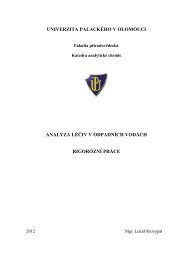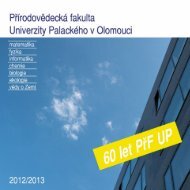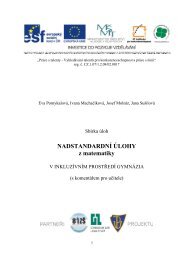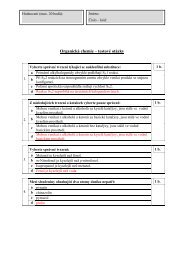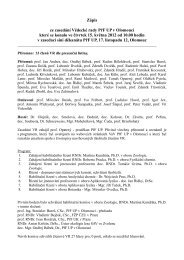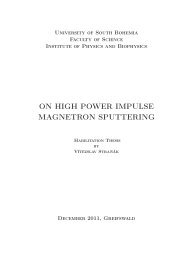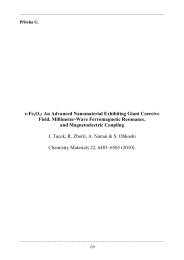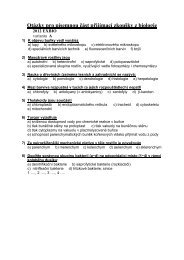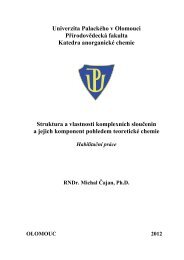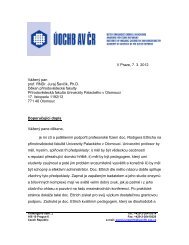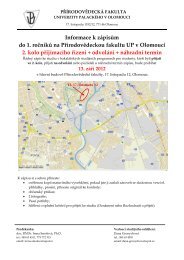J.SÏ amaj et al. Gachet,Y., Tournier,S., Millar,J.B.A. <strong>and</strong> Hyams,J.S. (2001) A MAP kinase-dependent actin checkpoint ensures proper spindle orientation in ®ssion yeast. Nature, 412, 352±355. Gibbon,B.C., Kovar,D.R. <strong>and</strong> Staiger,C.J. (1999) Latrunculin B has different effects on pollen germination <strong>and</strong> tube growth. Plant Cell, 11, 2349±2363. Hall,P.J., Cherkasova,V., Elion,E., Gustin,M.C. <strong>and</strong> Winter,E. (1996) The osmoregulatory pathway represses mating pathway activity in Saccharomyces cerevisiae: isolation <strong>of</strong> a FUS3 mutant that is insensitive to the repression mechanism. Mol. Cell. Biol., 16, 6715±6723. Harrison,J.C., Bardes,E.S.G., Ohya,Y. <strong>and</strong> Lew,D.J. (2001) A role for the Pkc1p/Mpk1p kinase cascade in the morphogenesis checkpoint. Nat. Cell Biol., 3, 1±5. Jiang,C.-J., Weeds,A.G. <strong>and</strong> Hussey,P.J. (1997) The maize actindepolymerizing factor, ZmADF3, redistributes to the growing tip <strong>of</strong> elongating root hairs <strong>and</strong> can be induced to translocate into the nucleus with actin. Plant J., 12, 1035±1043. Jonak,C., Kiegerl,S., Ligterink,W., Barker,P.J., Huskisson,N.S. <strong>and</strong> Hirt,H. (1996) Stress signaling in plants: a mitogen-activated protein kinase pathway is activated by cold <strong>and</strong> drought. Proc. Natl Acad. Sci. USA, 93, 11274±11279. Kamada,Y., Jung,U.S., Piotrowski,J. <strong>and</strong> Levin,D.E. (1995) The protein kinase C-activated MAP kinase pathway <strong>of</strong> Saccharomyces cerevisiae mediates a novel aspect <strong>of</strong> the heath shock response. Genes Dev., 9, 1559±1571. Kell,A. <strong>and</strong> Glaser,R.W. (1993) On the mechanical <strong>and</strong> dynamic properties <strong>of</strong> plant cell membranes: their role in growth, <strong>direct</strong> gene transfer <strong>and</strong> protoplast fusion. J. Theor. Biol., 160, 41±62. Kiegerl,S. et al. (2000) SIMKK, a mitogen-activated protein kinase (MAPK) kinase, is a speci®c activator <strong>of</strong> the salt stress-induced MAPK, SIMK. Plant Cell, 12, 2247±2258. Ko,K.S. <strong>and</strong> McCulloch,C.A.G. (2000) Partners in protection: interdependence <strong>of</strong> cytoskeleton <strong>and</strong> plasma membrane in adaptations to applied forces. J. Membr. Biol., 174, 85±95. Leinweber,B.D., Leavis,P.C., Grabarek,Z., Wang,C.L.A. <strong>and</strong> Morgan,K.G. (1999) Extracellular regulated kinase (ERK) interaction with actin <strong>and</strong> the calponin homology (CH) domain <strong>of</strong> actin-binding proteins. Biochem. J., 344, 117±123. Ligterink,W. <strong>and</strong> Hirt,H. (2001) Mitogen-activated protein (MAP) kinase pathways in plants: versatile signaling tools. Int. Rev. Cytol., 201, 209±215. Ligterink,W., Kroj,T., zur Nieden,U., Hirt,H. <strong>and</strong> Scheel,D. (1997) Receptor-mediated activation <strong>of</strong> a MAP kinase in pathogen defense <strong>of</strong> plants. Science, 276, 2054±2057. Mazzoni,C., Zarzov,P., Rambourg,A. <strong>and</strong> Mann,C. (1993) The SLT2 (MPK1) MAP kinase homolog is involved in polarized cell growth in Saccharomyces cerevisiae. J. Cell Biol., 123, 1821±1833. Miller,D.D., de Ruijter,N.C.A., Bisseling,T. <strong>and</strong> Emons,A.M.C. (1999) The role <strong>of</strong> actin in root hair morphogenesis: studies with lipochitooligosaccharide as a growth stimulator <strong>and</strong> cytochalasin as an actin perturbing drug. Plant J., 17, 141±154. Molendijk,A.J., Bisch<strong>of</strong>f,F., Rajendrakumar,C.S.V., Friml,J., Braun,M., Gilroy,S. <strong>and</strong> Palme,K. (2001) Arabidopsis thaliana Rop GTPases are localized to tips <strong>of</strong> root hairs <strong>and</strong> control polar growth. EMBO J., 20, 2779±2788. Munnik,T., Ligterink,W., Meskiene,I., Calderini,O., Beyerly,J., Musgrave,A. <strong>and</strong> Hirt,H. (1999) Distinct osmosensing protein kinase pathways are involved in signaling moderate <strong>and</strong> severe hyperosmotic stress. Plant J., 20, 381±388. NuÈhse,T., Peck,S.C., Hirt,H. <strong>and</strong> Boller,T. (2000) Microbial elicitors induce activation <strong>and</strong> dual phosphorylation <strong>of</strong> the Arabidopsis MAP kinase AtMPK6. J. Biol. Chem., 275, 7521±7526. Ovecka,M., BalusÏka,F., NadubinskaÂ,M. <strong>and</strong> Volkmann,D. (2000) Actomyosin <strong>and</strong> exocytosis inhibitors alter root hair morphology in Poa annua L. Biologia, 55, 105±114. Robinson,M.J. <strong>and</strong> Cobb,M.H. (1997) Mitogen-activated protein kinase pathways. Curr. Opin. Cell Biol., 9, 180±186. Robinson,M.J., Harkins,P.C., Zhang,J., Baer,R., Haycock,J.W., Cobb,M.H. <strong>and</strong> Goldsmith,E.J. (1996) Mutation <strong>of</strong> position 52 in ERK2 creates a nonproductive binding mode for adenosine 5¢-triphosphate. Biochemistry, 35, 5641±5646. Rousseau,S., Houle,F., L<strong>and</strong>ry,J. <strong>and</strong> Huot,J. (1997) p38 MAP kinase activation by vascular endothelial growth factor mediates actin reorganization <strong>and</strong> cell migration in human endothelial cells. Oncogene, 15, 2169±2177. SÏamaj,J., Braun,M., BalusÏka,F., Ensikat,H.J., Tsumuraya,Y. <strong>and</strong> Volkmann,D. (1999) Speci®c localization <strong>of</strong> arabinogalactan±protein epitopes at the surface <strong>of</strong> maize root hairs. Plant Cell Phys., 40, 874±883. Satiat-Jeunemaitre,B., Cole,L., Bourett,T., Howard,R. <strong>and</strong> Hawes,C. (1996) Brefeldin A effects in plant <strong>and</strong> fungal cells: something new about vesicle traf®cking? J. Microsc., 181, 162±177. SchaÈfer,C., Ross,S.E., Bragado,M.J., Groblewski,G.E., Ernst,S.A. <strong>and</strong> Williams,J.A. (1998) A role for the p38 mitogen-activated protein kinase/Hsp27 pathway in cholecystokinin-induced changes in the actin cytoskeleton in rat pancreatic acini. J. Biol. Chem., 273, 24173±24180. Seo,S., Okamoto,M., Seto,H., Ishizuka,K., Sano,H. <strong>and</strong> Ohashi,Y. (1995) Tobacco MAP kinase: a possible mediator in wound signal transduction pathways. Science, 270, 1988±1992. Shaw,S.L., Dumais,J. <strong>and</strong> Long,S.R. (2000) Cell surface expansion in polarly growing root hairs <strong>of</strong> Medicago truncatula. Plant Physiol., 124, 959±969. Sherrier,D.J. <strong>and</strong> V<strong>and</strong>enBosch,K.A. (1994) Secretion <strong>of</strong> cell wall polysaccharides in Vicia root hairs. Plant J., 5, 185±195. Staiger,C.J. (2000) Signaling to the actin cytoskeleton in plants. Annu. Rev. Plant Physiol. Plant Mol. Biol., 51, 257±288. Whitmarsh,A.J. <strong>and</strong> Davis,R.J. (1998) Structural organization <strong>of</strong> MAPkinase signaling modules by scaffold proteins in yeast <strong>and</strong> mammals. Trends Biochem. Sci., 23, 481±485. Wilson,C., Pfosser,M., Jonak,C., Hirt,H., Heberle-Bors,E. <strong>and</strong> Vicente,O. (1998) Evidence for the activation <strong>of</strong> a MAP kinase upon phosphate-induced cell cycle re-entry in tobacco cells. Physiol. Plant., 102, 532±538. Woodring,P.J., Hunter,T. <strong>and</strong> Wang,J.Y.J. (2001) Inhibition <strong>of</strong> c-Abl tyrosine kinase activity by ®lamentous actin. J. Biol. Chem., 276, 27104±27110. Zarzov,P., Mazzoni,C. <strong>and</strong> Mann,C. (1996) The SLT2 (MPK1) MAP kinase is activated during periods <strong>of</strong> polarized cell growth in yeast. EMBO J., 15, 83±91. Zhang,S. <strong>and</strong> Klessig,D.F. (1998) The tobacco wounding-activated mitogen-activated protein kinase is encoded by SIPK. Proc. Natl Acad. Sci. USA, 95, 7225±7230. Received January 11, 2002; revised March 26, 2002; accepted May 14, 2002 3306
Cell Biology International 27 (2003) 257–259 Short communication Involvement <strong>of</strong> MAP kinase SIMK <strong>and</strong> actin cytoskeleton in the regulation <strong>of</strong> root hair tip growth Jozef Samaj a,e , Miroslav Ovecka a,b,c* , Andrej Hlavacka b , Fatma Lecourieux a , Irute Meskiene a , Irene Lichtscheidl d , Peter Lenart a ,Ján Salaj e , Dieter Volkmann b , Laszlo Bögre f , Frantisek Baluska b,c , Heribert Hirt a a Institute <strong>of</strong> Microbiology <strong>and</strong> Genetics, Vienna Biocenter, Dr. Bohrgasse 9, 1030 Vienna, Austria b Institute <strong>of</strong> Botany, University <strong>of</strong> Bonn, Kirschallee 1, 53115 Bonn, Germany c Institute <strong>of</strong> Botany, Slovak Academy <strong>of</strong> Sciences, Dúbravská cesta 14, SK – 842 23 Bratislava, Slovak Republic d Institute <strong>of</strong> Ecology, University <strong>of</strong> Vienna, Althanstrasse 14, 1091 Vienna, Austria e Institute <strong>of</strong> Plant Genetics <strong>and</strong> Biotechnology, Slovak Academy <strong>of</strong> Sciences, Akademická 2, P. O. Box 39 A, SK – 950 07 Nitra, Slovak Republic f School <strong>of</strong> Biological Sciences, Royal Holloway, University <strong>of</strong> London, Egham, TW20 0EX London, UK Accepted 10 October 2002 Cell Biology International www.elsevier.com/locate/jnlabr/ycbir 1. Introduction Mitogen-activated protein kinases (MAPKs), a specific class <strong>of</strong> serine/threonine protein kinases, are involved in controlling many cellular functions in all eukaryotes. Signaling through MAPK cascades is involved in cell division, differentiation, <strong>and</strong> stress sensing. Recently, the stress induced MAPK (SIMK) (Munnik et al., 1999) <strong>and</strong> its upstream activator SIMKK (Kiegerl et al., 2000) have been characterized in Medicago sativa L. <strong>and</strong> shown to be inducible by osmotic stress <strong>and</strong> various fungal elicitors (Cardinale et al., 2000). In different plant species dense F-actin meshworks at the tip <strong>of</strong> root hairs were observed by immunolabeling with actin antibodies or in vivo using GFP fused to the F-actin binding domain <strong>of</strong> talin (Baluška <strong>and</strong> Volkmann, 2002; Baluška et al., 2000a; Braun et al., 1999). As MAPKs are involved in stress signaling to the actin cytoskeleton in yeast <strong>and</strong> animals, we have analyzed the function <strong>of</strong> the stress-activated alfalfa MAP kinase SIMK in root hairs. 2. Results <strong>and</strong> discussion In situ hybridization with an SIMK anti-sense probe revealed that SIMK was strongly expressed in alfalfa root hairs (Fig. 1). Previously, we have shown that * Corresponding author. Tel.: +421-2-59426-102; fax: +421-2-5477-1948. E-mail address: botuove@savba.sk (M. Ovecka). Fig. 1. In situ hybridization on alfalfa root sections with SIMK anti-sense (A) <strong>and</strong> sense (B, negative control) probes. (A) Superficial section through root showing that SIMK mRNA (appears as a specific purple-blue colour) is concentrated to root hairs (indicated by arrows) emerging along root body surface when section was hybridized with anti-sense probe. Less intense labeling could also be detected in root epidermis. (B) Similar superficial section showing no specific labeling <strong>of</strong> root section hybridized with the sense probe. Root hairs are indicated by arrows. Bar=70 µm. SIMK protein is predominantly localized to nuclei in meristematic cells <strong>of</strong> root apices (Baluška et al., 2000b). SIMK is also found in nuclei <strong>of</strong> elongating epidermal root cells. However, during bulge <strong>and</strong> root hair formation SIMK is not only polarly relocated from nuclei towards bulging domains <strong>of</strong> trichoblasts <strong>and</strong> tips <strong>of</strong> growing root hairs, but it is also activated <strong>and</strong> located at root hair tips in an active form. In trichoblasts, SIMK was located to peripheral spots predicting root hair outgrowth. In growing root hairs, SIMK was found to accumulate within root hair tips <strong>and</strong> in spot-like structures in the root hair tube. The selective enrichment <strong>of</strong> active SIMK in tips <strong>of</strong> emerging root hairs coincides 1065-6995/03/$ - see front matter 2003 Elsevier Science Ltd. All rights reserved. doi:10.1016/S1065-6995(02)00344-X




